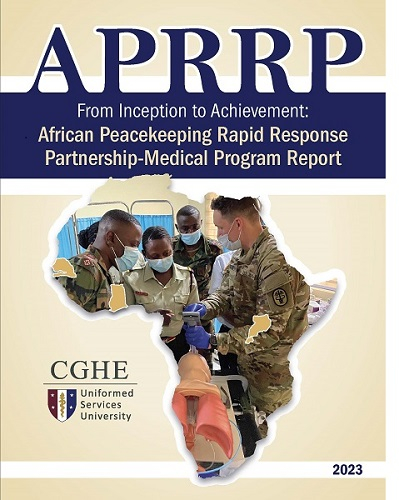Support to the African Peacekeeping Rapid Response Partnership (APRRP)
CGHE was tasked to manage and implement the APRRP Medical program in support of the USAFRICOM Command Surgeon’s office. Since inception, the focus of the program was to assist Ghana, Uganda, Rwanda, and Senegal to meet the mission end state: “by December 2022, the PN has a deployable Level 2 Hospital and is able to sustain this capability through organic training; hospital is registered at the Rapid Deployment Level (RDL) in the UN’s Peacekeeping Capability Readiness System (PCRS) and available to rapidly deploy to an emerging crisis.”
CGHE supported and enabled each PN to institutionalize training to support readiness to operate the L2H in a field setting. The crawl, walk, run model implemented by CGHE resulted in cadres of trainers and L2H training programs in each PN. Additionally, each PN demonstrated increased capacity to manage pre-deployment training programs to enable L2H operations and engaged in a process to actively plan for and manage the L2H package.
In 2023, APRRP LOEs transitioned to the Global Peace Operations Initiative. To enable the transition, CGHE worked with PN senior medical leadership to develop a plan to guide future investment and engagement; continuity and sustainability were the primary considerations. Each transition plan considered key training priorities; identified gaps, and the U.S. SMEs to advise and assist future efforts. While supporting the efforts of each PN, the experience gained over the six-year effort offers a reference point and model for future similar efforts.
In response to the COVID-19 pandemic, APRRP countries – with CGHE support – deployed U.S.-procured Level 2 field hospitals in support of their domestic pandemic response, all while working with USAFRICOM to leverage this medical capability to its fullest potential.
After the full close-out of APRRP, CGHE conducted an extensive review and analysis, and generated a summative medical program report on the entire program. This effort involved in-depth review and analysis of several hundred documents (post-engagement reports, technical assessment reports, program reports, and executive summaries), which spanned over 900 pages of documentation. The report was completed in early 2024, and the executive summary is available here.
